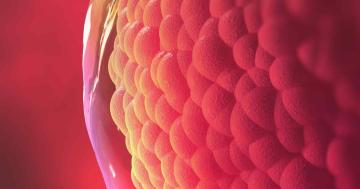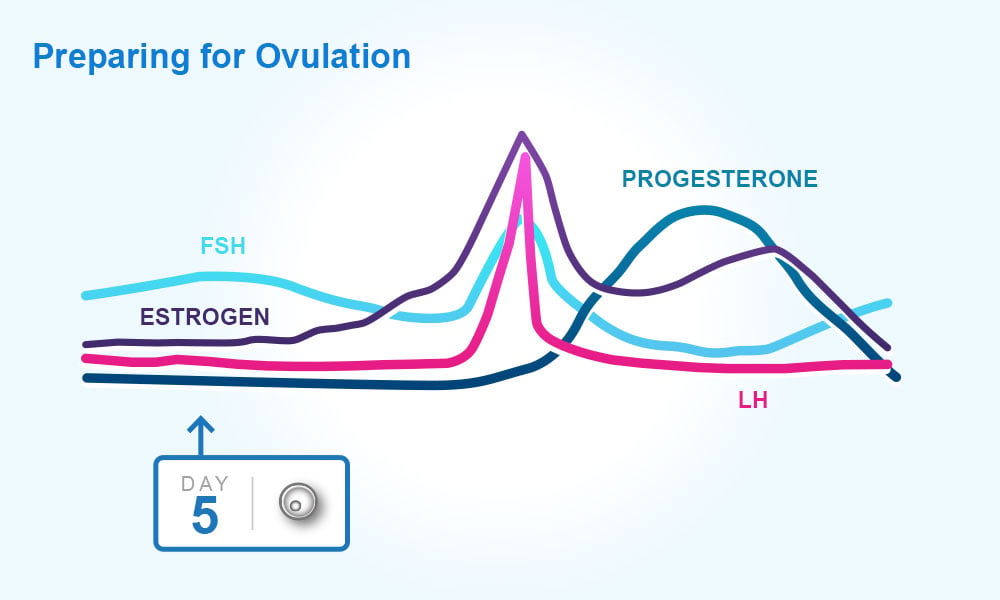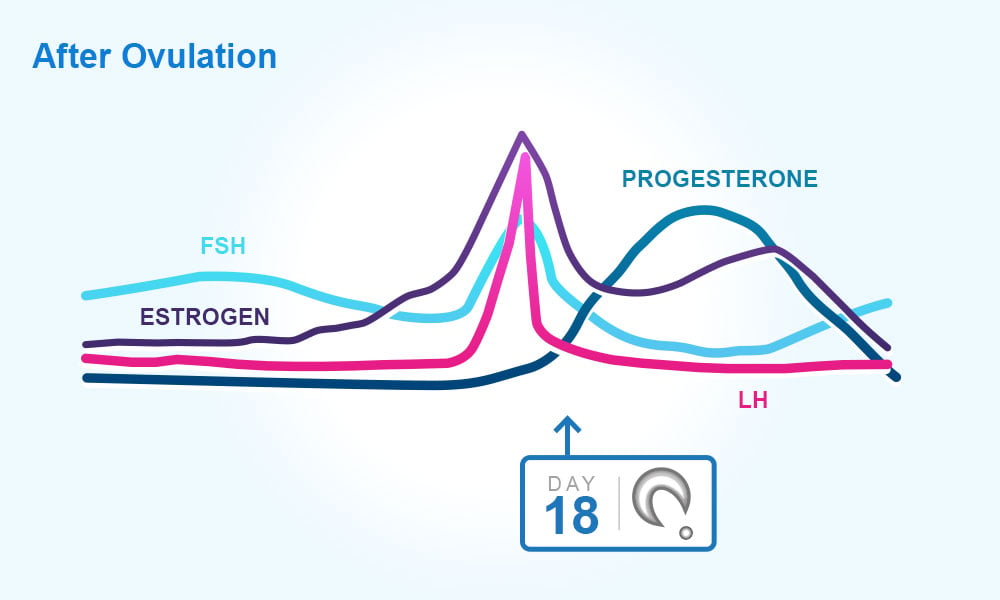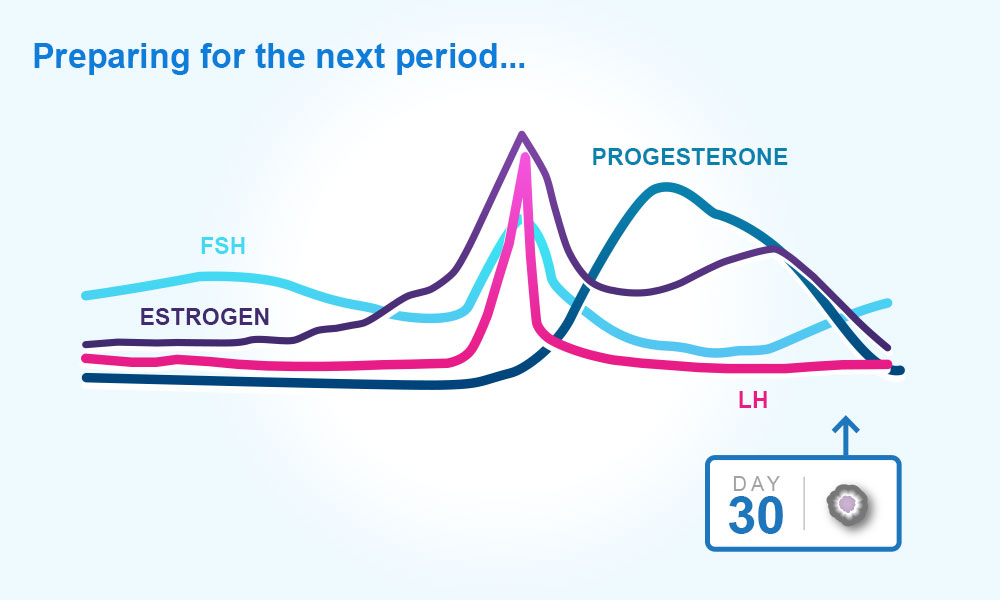
You probably already know quite a lot about your menstrual cycle – like how often you get your periods and how heavy they are. In this page we are going to take a more in-depth look at the female menstrual cycle, ovulation and periods. Obviously, no website can take the place of talking to a healthcare professional, but this should give you a good general understanding of how it all works.
Understanding your menstrual cycle
Women’s cycle lengths vary, and the most common cycle length is somewhere between 23 and 35 days. Any variation in menstrual cycle length that does occur is more likely to be during the part of the cycle before you ovulate (which is called the follicular phase). For most women, the length of time between ovulation (when an egg is released from the ovary) and their monthly period is between 12 to 16 days (this is called the luteal phase).
The menstrual cycle
Your period
The first day of your menstrual cycle is the first day of your period (day 1). The period usually then lasts anything from 3 to 7 days. You’ll probably find that if you get any period pains, they’ll be at their worst in the first few days of your period. This is because the hormones in your body are causing your womb to actively shed the lining that was built up in the previous menstrual cycle.
Preparing for ovulation
At the beginning of your cycle follicle-stimulating hormone (FSH) is produced by the pituitary gland in your brain. This is the main hormone involved in stimulating your ovaries to produce mature eggs. Follicles are the fluid-filled cavities in your ovaries. Each follicle contains one undeveloped egg. The FSH stimulates a number of follicles to develop and start to produce the hormone estrogen. Your level of estrogen is at its lowest on the first day of your period. From then on, it starts to increase as the follicles grow.
Now while a number of follicles initially begin to develop, normally one follicle becomes “dominant” and this egg matures within the enlarging follicle. At the same time, the increasing amount of estrogen in your body makes sure that the lining of your womb is thickening with nutrients and blood. This is so that if you do get pregnant, the fertilised egg will have all the nutrients and support it needs to grow. High estrogen levels are also associated with the appearance of ‘sperm-friendly’ mucus (or, to give it its technical name, fertile cervical mucus). You may notice this as a thin, slippery discharge that may be cloudy white. Sperm can swim more easily through this mucus and can survive in it for several days.
Your body produces hormones which control your menstrual cycle. At the start of your cycle one important hormone is follicle stimulating hormone [FSH]. The rise in FSH stimulates the follicles in your ovaries [fluid filled cavities that each contain one undeveloped egg] to develop and to start to produce another hormone called estrogen.
Understanding the ovulation cycle
Ovulation
The level of estrogen in your body is still increasing and it eventually causes a rapid rise in luteinising hormone (the ‘LH surge’). This LH surge causes the dominant follicle to rupture and release the mature egg from the ovary, from where it enters the Fallopian tube. This process is known as ovulation.
Many women think that they ovulate on day 14, but 14 is an average, and most women will actually ovulate on a different day of the menstrual cycle. Your day of ovulation will vary from cycle to cycle.. Some women claim to feel a twinge of pain when they ovulate, but many feel no sensation at all and there’s no other sign that you are ovulating.
An accurate way to identify your personal fertile days is to detect the changes in these key fertility hormones using an ovulation test.
Other commonly used methods to estimate when your most fertile days are for example, ovulation calendar methods, basal body temperature or saliva, are less accurate than hormone monitoring and are more likely to be affected by external factors such as illness or medication.
The level of estrogen in your body is still increasing and at a certain level it causes a rapid rise in LH [LH 'surge']. This LH surge triggers ovulation, where an egg is released from the ovary. Although many women think they ovulate on day 14, the actual day of ovulation will vary depending on your cycle length. Some women feel a twinge of pain when they ovulate.
After ovulation
Once the egg (or ovum) has been released, it moves along the Fallopian tube towards your womb. The egg can live for up to 24 hours. Sperm survival is more variable, but typically 3-5 days, so the days leading up to ovulation and the day of ovulation itself are your most fertile – when you are most likely to get pregnant. As soon as you have ovulated, the follicle starts producing another hormone: progesterone.
Progesterone causes further build up the lining of your womb in preparation for a fertilised egg. Meanwhile, the empty follicle within the ovary starts to shrink, but carries on producing progesterone, and also starts to produce estrogen. You may get symptoms of pre-menstrual tension (PMS) such as breast tenderness, bloating, lethargy, depression and irritability at this stage.
Once the egg has been released it moves along the Fallopian tube towards your womb. The egg lives for 12-24 hours, but because sperm can live for several days you are at your most fertile and most likely to get pregnant if you have sex without contraception on the day that you ovulate or the day before. As soon as you have ovulated the collapsed follicle starts producing another hormone called progesterone.
Preparing for the next period…
As the empty follicle shrinks, if the egg is not fertilised, levels of estrogen and progesterone decrease. Without the high levels of hormones to help maintain it, the thick womb lining that has been built up starts to break down, and your body sheds the lining. This is the start of your period and the beginning of your next menstrual cycle.
As the empty follicle shrinks, if the fertilised egg has not implanted into the womb, your level of progesterone decreases. The womb no longer needs to maintain an environment to support a baby so your body needs to reset ready for the next cycle. Any PMT (Pre-Menstrual Tension) symptoms that you have will start to decrease. Without the high levels of hormones to help maintain it, the thick womb lining which has built up starts to breakdown and your body will shed this. This is the start of your period and the beginning of your next cycle.
If the egg has been fertilised and implanted into the womb, the empty follicle is maintained by the increasing level of pregnancy hormone [human Chorionic Gonadotrophin]. It continues to produce estrogen and progesterone for much longer until the placenta is mature enough to support the developing embryo.
If the egg has been fertilised, it may successfully implant itself into the womb lining. This usually takes place about a week after fertilisation.
As soon as the fertilised egg has implanted, your body starts producing the pregnancy hormone, human Chorionic Gonadotrophin (hCG), which will keep the empty follicle active. It continues to produce the hormones estrogen and progesterone to prevent the lining of the womb from being shed, until the placenta (which contains all the nutrients the embryo needs) is mature enough to maintain the pregnancy.

Advanced digital ovulation test
In every cycle there are only a few days when a woman can conceive, so having sex on these days is very important if you are trying to get pregnant. The Clearblue® Advanced Digital Ovulation Test is the first and ONLY test that typically identifies 4 or more fertile days each cycle.

Get pregnant naturally
Ovulation tests are accurate and simple to use.







